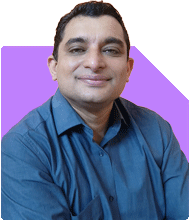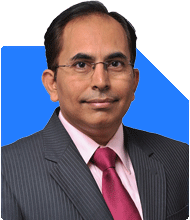38-Year-Old Aiming for Early Retirement at 55 with INR 4 Crore: Can He Achieve His Financial Goals?
Ramalingam Kalirajan |10902 Answers |Ask -Follow
Mutual Funds, Financial Planning Expert - Answered on Oct 09, 2024
He has an MBA in finance from the University of Madras and is a certified financial planner.
He is the director and chief financial planner at Holistic Investment, a Chennai-based firm that offers financial planning and wealth management advice.... more

Hello Sir, I am 38 now and Planning to retire at 55 with corpus of 4 Cr. I have took home loan of 32 lakh in 2021 which has current interest rate of 9.35% Also have Car loan of Rs 9 lakh took 2 yrs before with interest rate of 10% for 7 year. My take home salary is 1 lakh and rental income of Rs. 12k. Investments current value :- Parag Parikh Flexi cap 4.43 lakh(SIP10K) ICICI prudential Nifty next 50 2.94 lakh(SIP 5K) Kotak Equity opportunities 1.5 lakh Franklin ELSS 70k HDFC Mid cap opportunities 38k(SIP5k) Nippon India Small cap - 5k(SIP 5K) Value of shares in share market is around 9 lakh. Sukanya Samruddhi Yojana 4 lakh PPF 1.5 lakh EPF around 2 lakh I have daughter of 9 year oldand Son of 4 year old Need corpus for Education,Marriage and Retirement Also let me know MF selected are ok or I need to switch??
Your investments include mutual funds, equities, Sukanya Samriddhi Yojana (SSY), PPF, and EPF, and you also have two children (a 9-year-old daughter and a 4-year-old son). You are planning for their education, marriage, and your retirement. Let's evaluate your financial situation step-by-step and provide a detailed strategy to meet your goals.
Evaluating Your Current Loans
Home Loan: You took a Rs. 32 lakh home loan at an interest rate of 9.35%. The current interest rate environment makes your EMI relatively high. Home loans can be long-term commitments, and high interest could be draining a significant portion of your income.
Car Loan: You also have a Rs. 9 lakh car loan with a 10% interest rate. Auto loans are generally high-interest liabilities that depreciate as the vehicle loses value. This is a costly loan that can burden your monthly cash flow.
Recommendation:
Consider prepaying the car loan as early as possible since it comes with a high-interest rate and doesn't offer tax benefits. This will free up cash for other investments.
Look into refinancing your home loan. Check if you can reduce the interest rate by transferring the balance to another lender offering a lower rate. Even a slight reduction can save you a lot over time.
Analyzing Your Current Investments
You have built a good mix of investments in mutual funds, equities, and savings schemes. Let’s evaluate them:
Parag Parikh Flexi Cap (SIP of Rs. 10K): Flexi-cap funds offer the flexibility to invest across market capitalizations. This is a good long-term bet as it gives fund managers the freedom to choose based on market conditions.
ICICI Prudential Nifty Next 50 (SIP of Rs. 5K): You are investing in an index fund, but index funds, especially in the Next 50 category, tend to be more volatile. These funds may not provide as much flexibility as actively managed funds in the long term. Actively managed funds usually perform better during uncertain market conditions.
Kotak Equity Opportunities: Equity opportunities funds can be suitable for investors looking for long-term growth. Ensure this fund is regularly monitored, and stay in touch with your Certified Financial Planner (CFP) to review performance periodically.
Franklin ELSS: This is a tax-saving option. Equity Linked Saving Schemes (ELSS) also provide decent returns over the long term, with a lock-in period of three years. This fund category should remain part of your portfolio for tax saving and wealth creation.
HDFC Mid Cap Opportunities (SIP of Rs. 5K): Mid-cap funds have the potential to offer high returns but come with higher volatility. With 17 years to retirement, mid-caps can give you a good risk-reward balance if you have a long-term horizon.
Nippon India Small Cap (SIP of Rs. 5K): Small-cap funds have a higher risk but also potential for high returns. Keep this as a part of your long-term investment portfolio but ensure that the exposure to small-cap funds doesn't exceed 10-15% of your overall portfolio.
Shares: You have Rs. 9 lakh in direct equity investments. Equities are excellent for long-term growth, but you must monitor them regularly and stay updated on company performances. Direct equities can be riskier than mutual funds, so ensure diversification.
Sukanya Samriddhi Yojana (SSY): This is a great option for your daughter’s education and marriage, offering guaranteed returns and tax benefits under Section 80C. SSY should remain a core part of your financial planning for her future.
PPF (Rs. 1.5 lakh): PPF is a safe, tax-saving option that also provides good long-term returns. Continue investing in PPF for guaranteed, risk-free returns.
EPF (Rs. 2 lakh): EPF is another safe, long-term retirement saving option. It provides a steady, assured return and should continue to be a part of your retirement corpus.
Recommendation:
Actively managed funds may be a better option compared to index funds. They give fund managers flexibility to make strategic choices, potentially offering better returns, especially in volatile markets.
Continue your investments in mid-cap and small-cap funds but limit their proportion in your portfolio to avoid excessive risk.
Direct equity investment should be carefully monitored or handled through a CFP to avoid risk concentration.
Planning for Children's Education and Marriage
You have a 9-year-old daughter and a 4-year-old son. Education and marriage are significant future expenses that need careful planning.
Education: With education costs rising, start building a dedicated education fund for each child. You may need to allocate a specific portion of your SIPs or open a separate mutual fund portfolio for this goal. Plan for both higher education and school-related expenses.
Marriage: Marriage costs can be unpredictable. You could create a separate investment for marriage-related expenses in a balanced fund or a combination of fixed-income instruments and equities to ensure safety with some growth potential.
Recommendation:
Start allocating a portion of your income towards a dedicated education fund. This could include child-specific schemes like SSY or child-focused mutual funds.
Consider keeping marriage funds in low-risk, medium-return instruments to ensure they grow steadily without much risk exposure.
Assessing Your Retirement Plan
You aim to retire at 55 with a corpus of Rs. 4 crore. This is achievable with disciplined investing and strategic planning.
Current Investment Strategy: You are already investing in mutual funds, equities, and long-term savings plans like PPF and EPF. However, you need to ensure that your asset allocation is aligned with your retirement goals.
Debt Management: Your current loans should be repaid before retirement to avoid carrying financial liabilities post-retirement. Prepaying your car loan and refinancing your home loan could help you save significant amounts, which can then be redirected to investments.
Recommendation:
Focus on building a balanced portfolio of equity and debt to ensure your portfolio grows while also offering stability. Equity should dominate your portfolio in the early stages, while debt instruments can gradually take over as you approach retirement.
Increase your SIP contributions whenever your income increases. Aim to invest 25-30% of your monthly income towards retirement planning.
Evaluating Your Financial Goals and Future Course
You need to address three major goals: retirement, children's education, and marriage. Each goal requires a dedicated plan to ensure adequate corpus growth.
Recommendation:
For retirement, ensure that at least 60-70% of your portfolio is in growth-oriented instruments like equity mutual funds for now. As you approach retirement, gradually shift to debt funds for stability.
For your children's education, use a mix of equity mutual funds and child-specific investment schemes to ensure the corpus grows in line with education inflation.
For marriage expenses, opt for lower-risk instruments that offer predictable growth, such as balanced funds or a combination of equity and debt.
Final Insights
Loan Repayment: Focus on prepaying your high-interest car loan as soon as possible. This will free up cash flow for investments. Consider refinancing your home loan to reduce the interest burden.
Mutual Fund Strategy: You have a well-diversified portfolio. However, avoid index funds, as actively managed funds can provide better returns over the long term. Continue SIPs in flexi-cap, mid-cap, and small-cap funds but limit small-cap exposure.
Children's Future: Start separate SIPs for your children's education and marriage. SSY is a great option for your daughter’s future, but you may also need equity mutual funds for higher growth.
Retirement Corpus: With consistent investment and discipline, a Rs. 4 crore corpus is achievable. Aim to increase your SIP contributions periodically, keep monitoring your mutual fund performance, and consult with a CFP regularly to review your progress.
Best Regards,
K. Ramalingam, MBA, CFP,
Chief Financial Planner,
www.holisticinvestment.in
https://www.youtube.com/@HolisticInvestment
You may like to see similar questions and answers below
Ramalingam Kalirajan |10902 Answers |Ask -Follow
Mutual Funds, Financial Planning Expert - Answered on May 18, 2024
Ramalingam Kalirajan |10902 Answers |Ask -Follow
Mutual Funds, Financial Planning Expert - Answered on Jul 18, 2024
Ramalingam Kalirajan |10902 Answers |Ask -Follow
Mutual Funds, Financial Planning Expert - Answered on Aug 14, 2024
Ramalingam Kalirajan |10902 Answers |Ask -Follow
Mutual Funds, Financial Planning Expert - Answered on May 07, 2025
Reetika Sharma |429 Answers |Ask -Follow
Financial Planner, MF and Insurance Expert - Answered on Nov 07, 2025
Anu Krishna |1749 Answers |Ask -Follow
Relationships Expert, Mind Coach - Answered on Dec 17, 2025
Anu Krishna |1749 Answers |Ask -Follow
Relationships Expert, Mind Coach - Answered on Dec 17, 2025
Radheshyam Zanwar |6748 Answers |Ask -Follow
MHT-CET, IIT-JEE, NEET-UG Expert - Answered on Dec 17, 2025
Anu Krishna |1749 Answers |Ask -Follow
Relationships Expert, Mind Coach - Answered on Dec 17, 2025
Dr Shakeeb Ahmed Khan |184 Answers |Ask -Follow
Physiotherapist - Answered on Dec 17, 2025
T S Khurana |538 Answers |Ask -Follow
Tax Expert - Answered on Dec 17, 2025
T S Khurana |538 Answers |Ask -Follow
Tax Expert - Answered on Dec 17, 2025
Janak Patel |72 Answers |Ask -Follow
MF, PF Expert - Answered on Dec 17, 2025
Ramalingam Kalirajan |10902 Answers |Ask -Follow
Mutual Funds, Financial Planning Expert - Answered on Dec 17, 2025
Samraat Jadhav |2511 Answers |Ask -Follow
Stock Market Expert - Answered on Dec 17, 2025



























